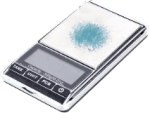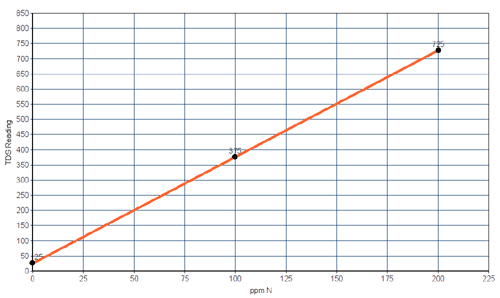If you’ve read my “EC & TDS” and “Don’t Trust Your TDS Meter” articles, you understand the inherent weaknesses of TDS meters and the unreliability of the data they provide. Don’t give up hope though! That inexpensive meter still has a lot of utility – if you know how to use it properly. Below is a method of simple TDS meter calibration that will do that for you.
First, you must figure out how much of your fertilizer to mix with water to make a solution of known concentration. The best way to do that is by weighing the powder accurately.

Let’s say, for example, that you have a 24-12-18 fertilizer and wish to apply it at a concentration of 100 ppm N, a good level for weekly application. As your fertilizer is 24% nitrogen by weight, your solution must contain 100 ppm/0.24 = 417 ppm of fertilizer. A part-per-million (ppm) is equivalent to a milligram-per-kilogram (mg/kg) and a liter of water weighs 1 kilogram. That means you must dissolve 417 mg of fertilizer powder in 1 liter of water (or 417 x 3.785 = 1578 mg in a gallon) to achieve your target nitrogen level.
That’s great, but what if you don’t have a scale? Another way – less accurate, but usually good enough – is to use powder volume to estimate the concentration. Using the following table to find the appropriate factor, divide the factor by the %N on the fertilizer label:
Volumetric Estimates - Divide this numerator by the fertilizer %N | ||||||||
ppm N | 25 | 50 | 75 | 100 | 125 | 150 | 175 | 200 |
tsp/gal | 2 | 4 | 6 | 8 | 10 | 12 | 14 | 13 |
ml/L | 2.6 | 5.2 | 7.8 | 11.4 | 14 | 16.6 | 19.2 | 21.8 |
For our 100 ppm N target, we would simply divide 8 by the %N on the label, meaning that we need to dissolve 8/24 = 1/3 teaspoon of fertilizer in a gallon of water (9.2/24 = 0.383 ml for a liter).
OK. Now that we know how much to mix, let’s set up the calibration testing. Using your TDS meter:
- Measure the TDS of your plain water with no fertilizer added. That’s your “zero ppm N” baseline.
- Make up your a double-concentrate – in other words, using the fertilizer from above, add 1/3 teaspoon to one-half gallon of water, giving a 200 ppm N solution – and measure the TDS of that.
- Add another half-gallon of water to that and measure the TDS again, this time of the 100 ppm solution.
- Make a graph, with the X-axis being ppm N scale and the Y-axis being TDS readings ( For this example, I arbitrarily chose 25, 375, and 775 ppm as my meter readings for 0, 100, and 200 ppm N solutions), drawing a straight line between the data points.

So now you have a calibration curve allowing you to make easy adjustments. For example, let’s say you decided to feed twice a week, so you’ll want to reduce the concentration to 50 ppm N. Just go to the “50 ppm N” line on the bottom axis, follow it up to your orange line, then left, showing that if you mix up a solution having a TDS meter reading of 200 ppm, you’re right there!
NOTE: If you change fertilizer formula or water source, you’ll need to generate a new calibration curve.